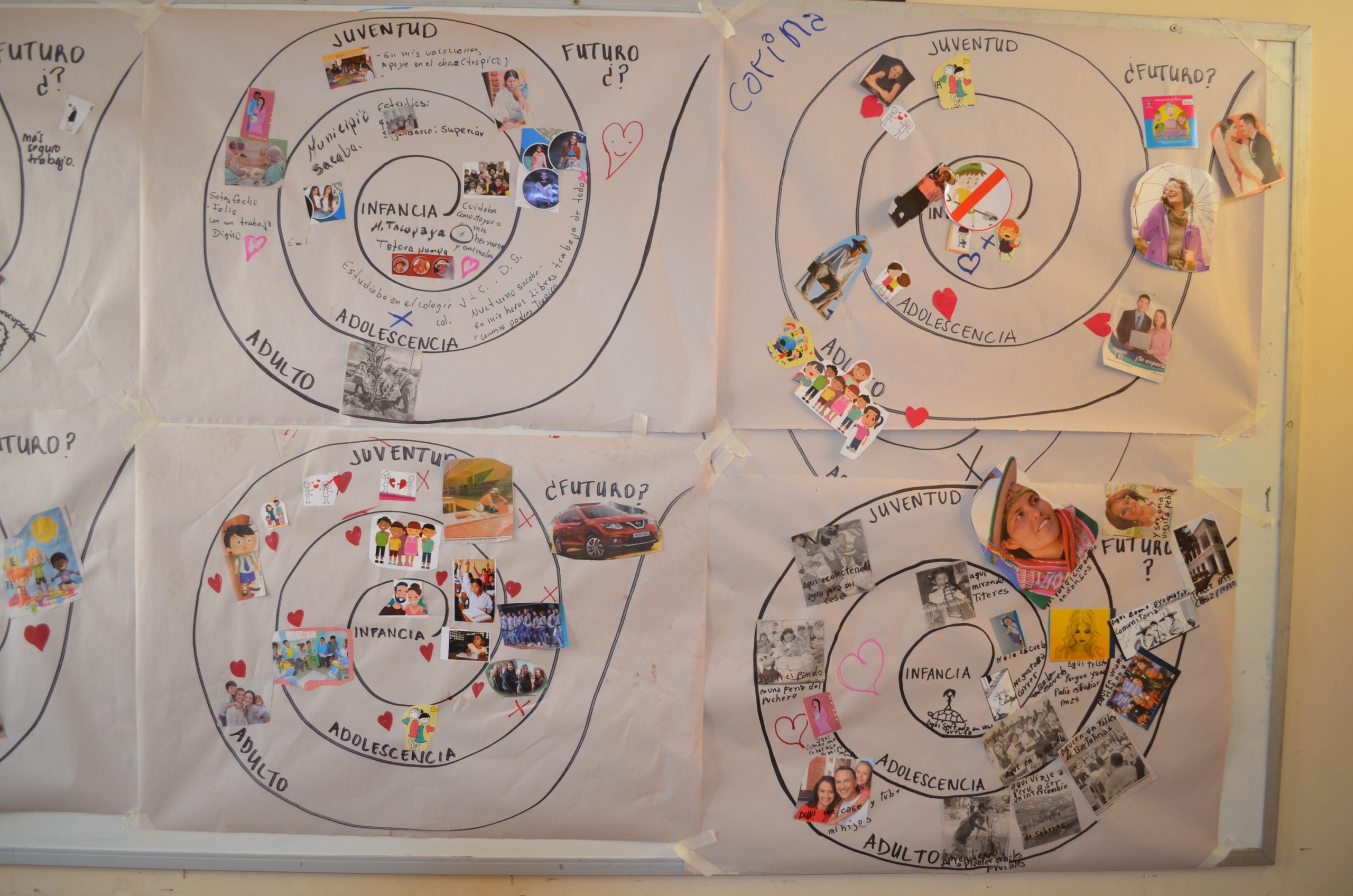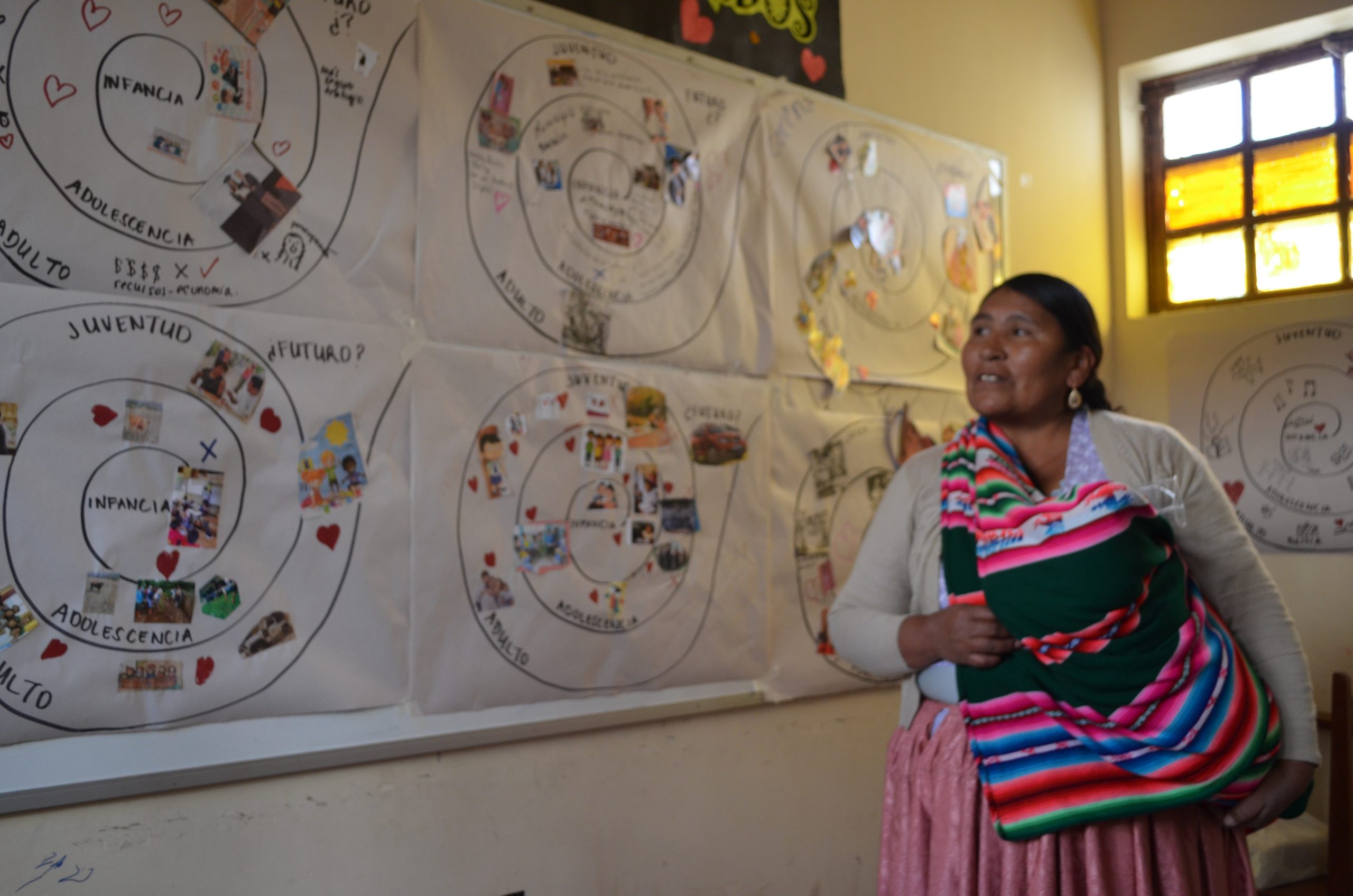Storytelling as a Research Method
As soon as I got out of school, we went to round up the animals, help with the harvest, and there, I felt happy in surroundings that were really life-giving; I laughed with my animals and I also had my friends, my neighbours, my cousins. Besides this, when I came to Cochabamba for the first time, it was a novelty for me, you know? Since I came by train and the city I saw was like seeing stars, I felt really happy. There I did sixth grade, but when you come from the countryside, there is always discrimination, and I arrived dressed in my pollerita and with my braids, and so everyone laughed at me. So this made me feel less, you know? And for this reason, I put on a blouse because I wanted to escape from where I came from and well, little by little, I became accustomed, I shared with others, and I learned to mingle and to speak Spanish
In late August 2019, the Cochabamba City Research Team organized a storytelling workshop, using the imagery of the mandala as a visual guide to share life stories. Storytelling as a research method is increasingly recognized as a creative and powerful approach to engage with diverse communities. Falling under the umbrella of participatory action research (PAR), the storytelling method allows for multiple and alternative narratives, or stories. This research project, for instance, explores intersecting inequalities and exclusionary practices in the city of Cochabamba, Bolivia. Engaging campesina (Spanish and Quechua speaking) women to share their stories helps ground our research on urban place-making in personal experiences, as the quote above illustrates.
Our team’s aim in hosting a storytelling workshop went beyond data collection. PAR is about building connections and community. For us, as researchers, this involves setting up space for mutual learning through open conversations. The in-depth interviews we held with interlocutors prior to the workshop revealed social stigmas around certain difficult issues, but also a desire among the women for spaces to network, to share, and to nurture friendships. Importantly, as researchers and facilitators, the team took part in the exercise to be open and vulnerable, and to narrow the distance between “interviewer” and “interviewee.”
The workshop was an occasion to connect with the interlocutors, and for the community to connect with the team outside of our roles as researchers. The mutual trust established through this exercise was a step towards a better research collaboration. It enabled us to reaffirm the project goals as a group, answer questions, and receive feedback in order to better engage with interlocutors on their ideas and knowledge throughout the research process.



Organizing the PAR session
As a team we brainstormed and drew upon our experiences of PAR to create an exercise that we felt would work well in Cochabamba. The step-by-step guide to the Mandala of Life Visual Storytelling method below may be useful for other researchers doing PAR, but this method should be adapted to the context in which it is used. The workshop is a budget-friendly research activity that requires a meeting space and few materials (e.g. paper, pens, glue). We chose the mandala as a visual guide for its symbolism of the circle of life. Using newspaper and magazine clippings, markers, paint, and chart paper, we created our mandalas de la vida (mandalas of life) that show our most important life events; the happy moments and the sad moments, from childhood to present, concluding with our hopes for the future. The rich stories capture feelings and perspectives that do not necessarily emerge during in-depth interviews.
PAR sessions do not always go smoothly or to plan, and that is okay. Remember, the key element of the storytelling workshop is to develop a mutual learning activity with research interlocutors. Below are some important considerations while facilitating a workshop:• Establish guidelines and boundaries as a group at the outset of the session and debrief about the workshop throughout the research process;
• Facilitators should actively participate in the exercise to build trust, openness, and horizontality;
• Acknowledge things in the moment and name them right away (e.g. “this is uncomfortable,” or “I’m the gringa from Canada”);
• Participants should leave the session feeling good and connected rather than sad or worried. Close the activity on a positive note (e.g. a personal strength; hopes for the future);
• PAR activities can generate strong emotions or conflicts. Consider mental health implications (what is the impact of this exercise?) and make contextually and culturally appropriate resources available and accessible for the participants.
Activity Guide
In this storytelling workshop, participants are asked to create personal mandalas de la vida (mandalas of life). Using collage materials, participants visually represent different important moments of their own life stories, from childhood, adolescence, youth, to adulthood. Guiding questions are provided to help participants reflect on the feelings, people, and spaces associated with their memories. Ending on a positive note, participants are also asked to include their wishes or dreams for the future. The mandalas are displayed and each participant has the opportunity to share their mandala and story with the group.
Objectives
• Facilitate connection and exchange in providing space for mutual learning of multiple stories and ways of knowing;
• Build storytelling tools to amplify interlocutors’ voices
Important considerations
• Provide an adequate honorarium as recognition of participants’ time and fully cover any other costs (travel, childcare, etc.);• Offer on-site childcare, or activities for children (e.g. materials for art and play during the session);
• Provide snacks and drinks;
• This activity can generate strong emotions or conflicts. Consider mental health implications (what is the impact of this exercise?) and make contextually and culturally appropriate resources available and accessible for the participants
Time
Approximately 2-3 hours depending on number of participants. The ideal range of participants is 10-12, with 2-3 facilitators.
Materials
• Markers (or other: crayons, coloring pencils, paint) • Flip chart paper (or other large size paper) • Collage materials (magazines, newspaper clippings) • Scissors • Name tags • Glue • TapeSteps
1. Facilitators introduce the workshop in the context of the research project, as applicable. As a group set, the ground rules for the session (e.g. no judgments, listen, share, respect). Following introductions, conduct a short and fun warm-up activity. 2. Each participant receives a piece of paper to create their own mandala using collage materials provided. The mandala spiral marks different periods of the participant’s life: childhood, adolescence, youth, and adulthood. Participants will create visual representations of the moments and memories that marked them in each period of their life. Marking the memory with an X to indicate a difficult time and a <3 (heart symbol) to indicate a joyful time. For each important moment of their life, participants are asked to reflect on the following questions (it is useful to have these questions in writing posted in the workshop space): Where were you?
What were you doing? Who were you with? How did you feel? The mandala spiral ends on the open-ended “future?” where the participant can indicate their hopes and dreams for the future. The facilitators circulate to assist participants throughout the mandala-making process. 3. Once the mandalas are complete, display them on the walls. Keeping in mind the questions above, each participant is invited to share as much or as little of their story as they choose with the group. 4. Invite participants to debrief and share their thoughts on the exercise. End the workshop on an uplifting note (e.g. another short and fun activity).










